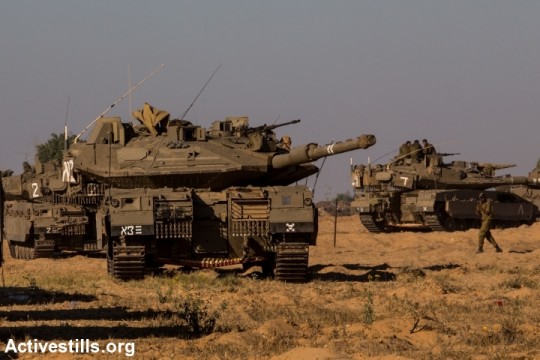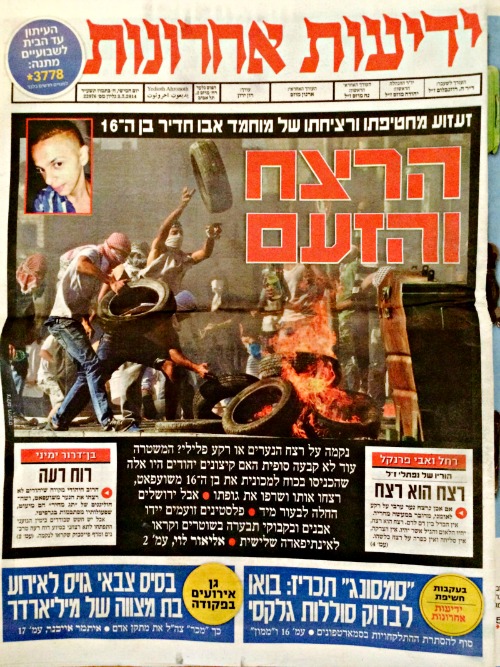No amount of Tweeting, tagging, posting or liking will save Gazans from an Israeli ground invasion. So why bother?
By Corey Sherman
Recent political upheavals in the Middle East tend to have a social media subplot, whether it’s how savvy youth use it to subvert harsh authority, or how states manipulate access to it so as to stop such subversion.
There’s the story about how State-Department-Official-cum-Google-Ideas-Chief, Jared Cohen, requested that Twitter delay a scheduled maintenance of their network to enable Iranians to continue to use the platform to organize during the harsh crackdown on post-election protests in 2009. Or how Josh Koster, an American advertising executive, crashed the servers of the Islamic Republic of Iran Broadcasting Agency to stymie the flow of the Iranian government’s official pronouncements during that same time. And let’s not forget the so-called Twitter Revolutionaries of the so-called Arab Spring.
It may be flippant to attempt to search for the subplot in what the Israeli government calls Operation Protective Edge. The fact is that no amount of Tweeting, tagging, posting or liking will save Gazans from an Israeli ground invasion. So why bother?
At the same time, the number of people running from bombs in Gaza or into shelters across southern and central Israel pales in comparison to the number of people experiencing this conflict on their mobile phones, their tablets or their computer screens. For most humans, this conflict exists only in the images, sounds and texts that are coming out of Israel/Palestine. The mass mediation of this conflict, both in print and online, is part of its story. How states, media organizations and citizens choose to tell the story of this conflict helps explain how interested parties perceive this current flare-up – and what they believe is at stake.
A Reminder of Resistance
The war in the south is only part of the story here right now. Over the weekend, Gregg Carlstrom (Politico Magazine) and JJ Goldberg (The Forward) contextualized, correctly, the current hostilities into the larger social upheaval occurring here since the kidnappings and killings of Gilad Shaar, Eyal Yifrah, Naftali Fraenkel, and Muhammed Abu Khdeir. Let’s not forget the 63-day-long hunger strike of Palestinian administrative detainees in Israeli jails, which ended amidst the hunt for Shaar, Yifrah, and Fraenkel’s bodies and their kidnappers.
In the heady days after Khdeir’s body was found charred in the Jerusalem forest, when Palestinians clashed with security services in East Jerusalem and in Palestinian towns and cities across Israel, Israeli and Palestinian media disseminated images that framed the clashes as relating to previous periods of unrest – namely the intifadas.
On July 3, Israeli daily Yedioth Ahronot’s front page contained a small picture of Abu Khdeir, and a larger picture, taking up most of the page, of Palestinians burning tires with the words “Murder and Rage” written in large red letters. The caption beneath the picture read, “Revenge for the murder of the boys or criminal act? The police are still not sure if extremist Jews were the ones who forced the 16-year-old from Shuafat into the car, killed him and burned his body, but Jerusalem began to burn immediately. Angry Palestinians threw stones and Molotov cocktails at the police amid calls for a Third Intifada.”
Inside the day’s edition, images and text reinforced the connection to an intifada. Along the border of the pages in the news section, banners reading “Murder and Escalation” were framed by pictures of Shaar, Yifrah and Fraenkel, and a stone-throwing Palestinian with a kuffiyeh wrapped around his head. Khdeir’s picture was, for the most part, absent on Yedioth’s inner pages, leaving the reader to think that the murder of the three Jewish boys was followed by an escalation in violence by Palestinians resorting to the age-old tactic of throwing rocks at Israeli authorities.
Four days later, the day Israel would begin Operation Protective Edge, the faces of the boys disappeared, but the stone-thrower remained, this time with the caption: “stop the bloodshed.”
Such a framing of events reduces Palestinian action to fits of rage and irrationality. Furthermore, it ignores the fact that, as this publication has pointed out, the occupation and resistance to it occur daily and in both overt and covert ways.
For some in Palestine, though, social media serves as a platform to wrestle this narrative away from those who trivialize resistance to the occupation.
“The drive to resistance,” one Palestinian student activist told me, “is inside every Palestinian – even though the emotions may wane from time to time.”
In the days after Abu Khdeir’s body was found, this student who studies philosophy and political science at the Hebrew University in Jerusalem, was one of several friends of mine on Facebook who changed their profile pictures to a drawing of Khdeir. “The execution of Abu Khedir redefined what it means to be a Palestinian, and is making people aware of their role in freeing the Palestinian people from the occupation,” he said.
“The resistance will remain active until the Palestinian people are free, he explained. “The reaction of the street [after the kidnappings] is the natural response of the people under occupation.”
For Yedioth, that same resistance is unpredictable – hidden from view but always lurking. For the student activist, resistance, like the occupation, is a daily fact – which is why Facebook is an apt venue for his activism.
Some good ol’ hasbara
The use of mass media for psychological warfare and propaganda is not new in Israel’s conflicts with the Palestinians and Arab States. Over the last week, however, social media, specifically the popular and playful platforms of Instagram and YouTube, provided a venue for Israelis to present a palatable international image, and to instruct others how to win the war of ideas.
Ron Dermer’s interview on CBS Face the Nation Sunday seemed less like a news interview and more like an advertisement for Israel’s closely linked high-tech industry and military culture. Thirty seconds into the interview, host Bob Shieffer asks the Israeli Ambassador to the US about how he stays informed of rocket attacks from afar. “It’s not just Israel’s Ambassadors [who] can get [rocket alert sirens] on their phone, anyone can get it on their phone,” Dermer beamed with pride. “They can download an app called ‘Red-Alert Israel,’ and what happens is every time a siren goes off in an Israeli city when an incoming rocket is coming in, you’ll get it on your phone and you’ll know exactly what city is being targeted and when it is being targeted.”
Later in the interview, while explaining Israel’s view of the allegations that it targets civilians in Gaza, the phone brings to millions of viewers in the United States the sirens heard in Israeli cities that send frightened parents and screaming children into hiding. What we end up seeing is an Israeli official on live television demonstrating for viewers how they can simulate the genuine fear those sirens evoke in people living here. In so doing he draws people closer to a conflict that they will never experience firsthand.
Hamas, for their part, does more or less the same, though on a much smaller scale. This YouTube video, which has a paltry 2,689 views, instructs Gazans as to how to effectively engage on social media. The Times of Israel Arab Affairs Correspondent, Elhanan Miller, translated the video last week. Hamas instructs Gazans to refrain from posting locations of rocket launchers; to use the terms “innocent civilian” to describe those killed; to explain that the rockets are a natural response to the occupation; and to post pictures of those injured in the attacks.
Such cynical propaganda should call into question the extent to which either side has an interest in annihilating the other or whether they seek only to draw attention to the strife that their populations are feeling at this current time – strife that would decrease if the fighting ceased.
***
Lee Smith wrote last week in Tablet Magazine that the failure of the American-led peace talks set the region ablaze. An examination of the conflict’s presentation in mass media should call into question such a notion. Forget questions about land swaps and how to divide Jerusalem, Israelis and Palestinians are simply far apart on issues of vital importance, such as what constitutes legitimate resistance to a military occupation, and who is responding to whose rocket fire.
Rather than blame the US for the failure of the peace talks, the question should be why the US even bothered in the first place.
Related:
What does Israeli ‘acceptance’ of ceasefire really mean?
Details of Palestinian deaths jeopardize a system of denial
How the public was manipulated into believing the teens were alive




